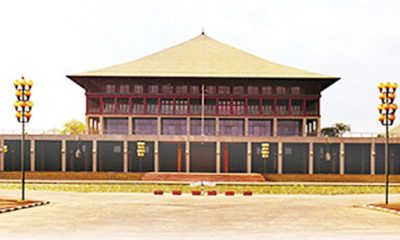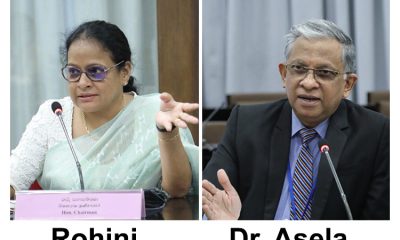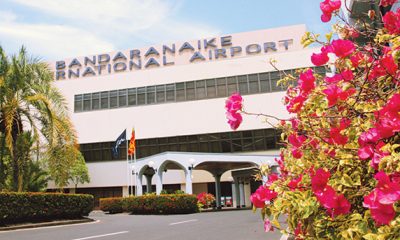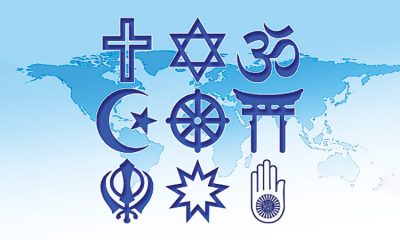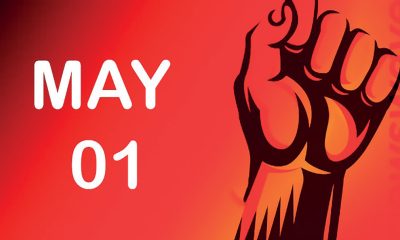Features
Red lining; snipping off; banning

 What my title means is censorship which when actually carried out could be using a red pen to delete sections of writing; cutting off parts of film and banning if the spoken word is censored which means suppressing and prohibiting speech. The definition of the term censorship is: “The suppression or prohibition of any parts of books, films, news, etc that are considered obscene, politically unacceptable, or a threat to security.” And now censorship covers all media: written, spoken via appliances and depicted in films, videos et al, and electronic.
What my title means is censorship which when actually carried out could be using a red pen to delete sections of writing; cutting off parts of film and banning if the spoken word is censored which means suppressing and prohibiting speech. The definition of the term censorship is: “The suppression or prohibition of any parts of books, films, news, etc that are considered obscene, politically unacceptable, or a threat to security.” And now censorship covers all media: written, spoken via appliances and depicted in films, videos et al, and electronic.
History of censorship
I read with interest a long Britannica article in Internet which traces the history of the banning of the written and spoken word. All countries have descended to censorship, very markedly Russia and China. During Confucius’ time (551-479 BC), deference to elders and authority was insisted upon and so those who broke these norms were censored and punished.
A detailed account was given of censorship within the Grecian Civilization – 900 BCE to 600 CE. Although Greece initiated the earliest of democracies where citizens ruled the country and open debate was encouraged, censorship came in when a refusal to conform arose, outwardly to recognized worship. The community subjected such irreligious persons to hardships.
If a person spoke improperly, legal sanctions were forthcoming. Athens particularly, more than other States of the Grecian Empire, allowed freedom of speech, particularly political. However we have the case of one of its most wise and freely speaking philosophers – Socrates – being tried, convicted and executed in 399 BC; accused of corrupting youth mainly because he did not acknowledge gods and expressed it.
Rome had its golden times when anybody could speak openly in the period between the leadership of Nerva (30-98 CE) and Marcus Aurelius (121 -180 CE). Tacitus wrote that a citizen could hold and defend whatever opinions he wished to.
Christendom and the rise in power and influence of the Catholic Church brought in severe censorship and excommunication from the Church. Consider what happened to Galileo Galilei of Pisa, Italy, 1564-1642. He declared “And yet it moves”; it being the Earth. The Christian and European belief was that Earth was at the centre of the universe and therefore stood still. Galileo was convinced that model was wrong, although he could not prove it. He was censored but punishment was comparatively mild. His book was banned; and he was sentenced to light penance and imprisonment, commuted to ‘villa arrest’.
Medieval Europe where religion closely influenced politics had witch hunts and the trial of Joan of Arc and her being burnt at the stake. The Age of Enlightenment -17th and 18th centuries – ushered in a freer time.
A great landmark in freedom from censorship was the promulgation of, and ratification of the US Constitution in 1791. “Congress shall make no laws respecting an establishment of religion, or prohibiting the free exercise thereof, or abridging the freedom of speech or of the press; or the right of the people peaceably to assemble, and to petition the government for redress of grievances.”
Very much in mind is George Orwell’s 1949 novel Nineteen Eighty Four with reference to the future of the world according to what was prevalent in Russia where suppression and government prying reached a crescendo to the point of making human life worthless living.
Also Oscar Wilde (1854-1900), Irish writer, clever wit, Victorian celebrity for his elegant appearance, was banned and hounded out of Britain by government decree in 1895 at the height of his theatre success. He was censored for his behavior – ‘gross indecency’ consequent to being reported as indulging in homosexual acts, though consensual. He moved to live in a hotel in France and died at age 47 of an infected ear causing meningitis.
The most infamous and ludicrous act of governments’ censorship was banning D H Lawrence’s Lady Chatterley’s Lover for explicitness in description and obscenity of language– the use of the f word which is so freely used now by even kids. The UK brought a case against publisher Penguin in 1928. The US banned the book in 1929 and many other countries followed. Ban was lifted in the US in 1959 and UK in 1960.
You will note I have touched on only early Western censorship; nothing on Indian or Sri Lankan. My reference was the Britannica article, and matters I had in mind. I am not competent to write about early censorship in my country and India.
Latest Indian Ban
The above was by way of introduction to the subject of censorship and banning. My main story is centered on Arundathi Roy who two weeks ago was charged by Indian government announcement and may face imprisonment. “She is accused of provocative speech and promoting enmity between different groups merely for comments made in 2010 that questioned the Indian Government’s claims to the disputed, restive region of Kashmir. But the real reason she is targeted now – 13 years later – is surely her courageous criticism of the intolerance and violence unleashed under Mr Modi. People like her are among India’s greatest assets because they stand for truth and decency, but they are being cast as enemies of the state.
India is devouring its best and brightest.” The woman writer in a recent New York Times (apologies for not noting down her name) went on to say: “Charges against Ms Roy are typically absurd. She has been a voice for truth, tolerance and sanity in India for decades. Her books and essays record the utter apathy of the post-independence ruling class as India descends into the chaos of Mr Modi’s right wing politics. Jailing Ms Roy would be not unlike America imprisoning a writer of the moral stature of Toni Morrison or James Baldwin.”
Added in the article are these facts. Since 2014 when Modi came to power, the Hindu nationalist mob has targeted Muslims, students, activists, opposition politicians and Dalits. We in Sri Lanka have had less mob violence except among the drug mafia, but the police have been increasingly using strong arm tactics against protesters, peaceful though they be. However, we will never forget the white vans during Mahinda – Gotabaya Rajapaksa regime and the number of journalists who were kidnapped, assaulted, killed too, and one woman journo whose life was in danger and was spirited away. She dared to bare MIG business and quoted word for word an interview she conducted.
Going back to the latest and best known censored person in India, Arundathi Roy, in September this year she won the prestigious European Essay Prize for, as the jury stated: “Using the essay as a form of combat, analyzing fascism and the way it is being structured.”
In 1997 Arundathi Roy won the Booker Prize for her first novel God of Small Things. She stopped writing fiction and concentrated on political protests such as against the five dams of the Damodar Valley Corporation which dislocated hundreds of poor families. She undertook lecture tours in the US and did not mince her words criticizing the host country. In 2017, after a lapse of 20 years fiction writing, she published her second novel Ministry of Utmost Happiness in which almost a quarter of the book is a political diatribe on the suffering of the people of divided Kashmir. Her collection of essays she titled My Seditious Heart.
Thus it appears that in addition to other negatives like religious conflict and Hindu supremacy in India, censorship and banning of criticism of government is coming in strong.
Over here
The most pertinent question to us is: Are we imitating or following Big Brother across the Palk Straits? This burning question is consequent to a most troublous, ominous move of President Ranil Wickremesinghe’s SLPP dominant government in presenting on October 3 in Parliament the ‘Online Safety Bill’. The first question that surfaced in my mind was: whose safety is being ensured? Not the general public’s by any means. The government is bringing in draconian restrictions to safeguard itself.
According to the Bill, “A commission of five individuals appointed by the President will be empowered to block any social media account, prosecute, fine and even imprison individuals.”
Now if this Bill is not the forerunner, harbinger and warning sign of censorship, what is? It has been protested against. It must not be allowed to become an Act.
Postscript
BBC News on Wednesday November 1 announced the first ever Artificial Intelligence Safety Summit convened by leading AI nations, businesses, civil society and AI experts, to discuss the global future of AI and to share understanding on the risks it poses.
On October 15 in this column I wrote about AI. What caught my fancy in the news of the Summit starting on November 1 is that the venue is Bletchley Park, Buckinghamshire. Here it was that in1935 crypto analyst Alan M Turing and other experts were closeted and given the task of decrypting WW II German intelligence messages. Turing built a machine to do the decoding which, it is said to be, the forerunner of all computers.
His inventive idea of “a machine of limitless memory, scanner that moves symbol by symbol reading what it finds and writing further symbols was the first beginning of AI.” The AI Summit venue is so appropriate and an indirect sign of respect to those earliest in the field of AI though they had not even the use of a computer then. Turin’s theoretical design, vague though it was, is accepted as the first original forerunner of artificial intelligence.
Features
The heart-friendly health minister

by Dr Gotabhya Ranasinghe
Senior Consultant Cardiologist
National Hospital Sri Lanka
When we sought a meeting with Hon Dr. Ramesh Pathirana, Minister of Health, he graciously cleared his busy schedule to accommodate us. Renowned for his attentive listening and deep understanding, Minister Pathirana is dedicated to advancing the health sector. His openness and transparency exemplify the qualities of an exemplary politician and minister.
Dr. Palitha Mahipala, the current Health Secretary, demonstrates both commendable enthusiasm and unwavering support. This combination of attributes makes him a highly compatible colleague for the esteemed Minister of Health.
Our discussion centered on a project that has been in the works for the past 30 years, one that no other minister had managed to advance.
Minister Pathirana, however, recognized the project’s significance and its potential to revolutionize care for heart patients.
The project involves the construction of a state-of-the-art facility at the premises of the National Hospital Colombo. The project’s location within the premises of the National Hospital underscores its importance and relevance to the healthcare infrastructure of the nation.
This facility will include a cardiology building and a tertiary care center, equipped with the latest technology to handle and treat all types of heart-related conditions and surgeries.
Securing funding was a major milestone for this initiative. Minister Pathirana successfully obtained approval for a $40 billion loan from the Asian Development Bank. With the funding in place, the foundation stone is scheduled to be laid in September this year, and construction will begin in January 2025.
This project guarantees a consistent and uninterrupted supply of stents and related medications for heart patients. As a result, patients will have timely access to essential medical supplies during their treatment and recovery. By securing these critical resources, the project aims to enhance patient outcomes, minimize treatment delays, and maintain the highest standards of cardiac care.
Upon its fruition, this monumental building will serve as a beacon of hope and healing, symbolizing the unwavering dedication to improving patient outcomes and fostering a healthier society.We anticipate a future marked by significant progress and positive outcomes in Sri Lanka’s cardiovascular treatment landscape within the foreseeable timeframe.
Features
A LOVING TRIBUTE TO JESUIT FR. ALOYSIUS PIERIS ON HIS 90th BIRTHDAY

by Fr. Emmanuel Fernando, OMI
Jesuit Fr. Aloysius Pieris (affectionately called Fr. Aloy) celebrated his 90th birthday on April 9, 2024 and I, as the editor of our Oblate Journal, THE MISSIONARY OBLATE had gone to press by that time. Immediately I decided to publish an article, appreciating the untiring selfless services he continues to offer for inter-Faith dialogue, the renewal of the Catholic Church, his concern for the poor and the suffering Sri Lankan masses and to me, the present writer.
It was in 1988, when I was appointed Director of the Oblate Scholastics at Ampitiya by the then Oblate Provincial Fr. Anselm Silva, that I came to know Fr. Aloy more closely. Knowing well his expertise in matters spiritual, theological, Indological and pastoral, and with the collaborative spirit of my companion-formators, our Oblate Scholastics were sent to Tulana, the Research and Encounter Centre, Kelaniya, of which he is the Founder-Director, for ‘exposure-programmes’ on matters spiritual, biblical, theological and pastoral. Some of these dimensions according to my view and that of my companion-formators, were not available at the National Seminary, Ampitiya.
Ever since that time, our Oblate formators/ accompaniers at the Oblate Scholasticate, Ampitiya , have continued to send our Oblate Scholastics to Tulana Centre for deepening their insights and convictions regarding matters needed to serve the people in today’s context. Fr. Aloy also had tried very enthusiastically with the Oblate team headed by Frs. Oswald Firth and Clement Waidyasekara to begin a Theologate, directed by the Religious Congregations in Sri Lanka, for the contextual formation/ accompaniment of their members. It should very well be a desired goal of the Leaders / Provincials of the Religious Congregations.
Besides being a formator/accompanier at the Oblate Scholasticate, I was entrusted also with the task of editing and publishing our Oblate journal, ‘The Missionary Oblate’. To maintain the quality of the journal I continue to depend on Fr. Aloy for his thought-provoking and stimulating articles on Biblical Spirituality, Biblical Theology and Ecclesiology. I am very grateful to him for his generous assistance. Of late, his writings on renewal of the Church, initiated by Pope St. John XX111 and continued by Pope Francis through the Synodal path, published in our Oblate journal, enable our readers to focus their attention also on the needed renewal in the Catholic Church in Sri Lanka. Fr. Aloy appreciated very much the Synodal path adopted by the Jesuit Pope Francis for the renewal of the Church, rooted very much on prayerful discernment. In my Religious and presbyteral life, Fr.Aloy continues to be my spiritual animator / guide and ongoing formator / acccompanier.
Fr. Aloysius Pieris, BA Hons (Lond), LPh (SHC, India), STL (PFT, Naples), PhD (SLU/VC), ThD (Tilburg), D.Ltt (KU), has been one of the eminent Asian theologians well recognized internationally and one who has lectured and held visiting chairs in many universities both in the West and in the East. Many members of Religious Congregations from Asian countries have benefited from his lectures and guidance in the East Asian Pastoral Institute (EAPI) in Manila, Philippines. He had been a Theologian consulted by the Federation of Asian Bishops’ Conferences for many years. During his professorship at the Gregorian University in Rome, he was called to be a member of a special group of advisers on other religions consulted by Pope Paul VI.
Fr. Aloy is the author of more than 30 books and well over 500 Research Papers. Some of his books and articles have been translated and published in several countries. Among those books, one can find the following: 1) The Genesis of an Asian Theology of Liberation (An Autobiographical Excursus on the Art of Theologising in Asia, 2) An Asian Theology of Liberation, 3) Providential Timeliness of Vatican 11 (a long-overdue halt to a scandalous millennium, 4) Give Vatican 11 a chance, 5) Leadership in the Church, 6) Relishing our faith in working for justice (Themes for study and discussion), 7) A Message meant mainly, not exclusively for Jesuits (Background information necessary for helping Francis renew the Church), 8) Lent in Lanka (Reflections and Resolutions, 9) Love meets wisdom (A Christian Experience of Buddhism, 10) Fire and Water 11) God’s Reign for God’s poor, 12) Our Unhiddden Agenda (How we Jesuits work, pray and form our men). He is also the Editor of two journals, Vagdevi, Journal of Religious Reflection and Dialogue, New Series.
Fr. Aloy has a BA in Pali and Sanskrit from the University of London and a Ph.D in Buddhist Philosophy from the University of Sri Lankan, Vidyodaya Campus. On Nov. 23, 2019, he was awarded the prestigious honorary Doctorate of Literature (D.Litt) by the Chancellor of the University of Kelaniya, the Most Venerable Welamitiyawe Dharmakirthi Sri Kusala Dhamma Thera.
Fr. Aloy continues to be a promoter of Gospel values and virtues. Justice as a constitutive dimension of love and social concern for the downtrodden masses are very much noted in his life and work. He had very much appreciated the commitment of the late Fr. Joseph (Joe) Fernando, the National Director of the Social and Economic Centre (SEDEC) for the poor.
In Sri Lanka, a few religious Congregations – the Good Shepherd Sisters, the Christian Brothers, the Marist Brothers and the Oblates – have invited him to animate their members especially during their Provincial Congresses, Chapters and International Conferences. The mainline Christian Churches also have sought his advice and followed his seminars. I, for one, regret very much, that the Sri Lankan authorities of the Catholic Church –today’s Hierarchy—- have not sought Fr.
Aloy’s expertise for the renewal of the Catholic Church in Sri Lanka and thus have not benefited from the immense store of wisdom and insight that he can offer to our local Church while the Sri Lankan bishops who governed the Catholic church in the immediate aftermath of the Second Vatican Council (Edmund Fernando OMI, Anthony de Saram, Leo Nanayakkara OSB, Frank Marcus Fernando, Paul Perera,) visited him and consulted him on many matters. Among the Tamil Bishops, Bishop Rayappu Joseph was keeping close contact with him and Bishop J. Deogupillai hosted him and his team visiting him after the horrible Black July massacre of Tamils.
Features
A fairy tale, success or debacle

Sri Lanka-Singapore Free Trade Agreement
By Gomi Senadhira
senadhiragomi@gmail.com
“You might tell fairy tales, but the progress of a country cannot be achieved through such narratives. A country cannot be developed by making false promises. The country moved backward because of the electoral promises made by political parties throughout time. We have witnessed that the ultimate result of this is the country becoming bankrupt. Unfortunately, many segments of the population have not come to realize this yet.” – President Ranil Wickremesinghe, 2024 Budget speech
Any Sri Lankan would agree with the above words of President Wickremesinghe on the false promises our politicians and officials make and the fairy tales they narrate which bankrupted this country. So, to understand this, let’s look at one such fairy tale with lots of false promises; Ranil Wickremesinghe’s greatest achievement in the area of international trade and investment promotion during the Yahapalana period, Sri Lanka-Singapore Free Trade Agreement (SLSFTA).
It is appropriate and timely to do it now as Finance Minister Wickremesinghe has just presented to parliament a bill on the National Policy on Economic Transformation which includes the establishment of an Office for International Trade and the Sri Lanka Institute of Economics and International Trade.
Was SLSFTA a “Cleverly negotiated Free Trade Agreement” as stated by the (former) Minister of Development Strategies and International Trade Malik Samarawickrama during the Parliamentary Debate on the SLSFTA in July 2018, or a colossal blunder covered up with lies, false promises, and fairy tales? After SLSFTA was signed there were a number of fairy tales published on this agreement by the Ministry of Development Strategies and International, Institute of Policy Studies, and others.
However, for this article, I would like to limit my comments to the speech by Minister Samarawickrama during the Parliamentary Debate, and the two most important areas in the agreement which were covered up with lies, fairy tales, and false promises, namely: revenue loss for Sri Lanka and Investment from Singapore. On the other important area, “Waste products dumping” I do not want to comment here as I have written extensively on the issue.
1. The revenue loss
During the Parliamentary Debate in July 2018, Minister Samarawickrama stated “…. let me reiterate that this FTA with Singapore has been very cleverly negotiated by us…. The liberalisation programme under this FTA has been carefully designed to have the least impact on domestic industry and revenue collection. We have included all revenue sensitive items in the negative list of items which will not be subject to removal of tariff. Therefore, 97.8% revenue from Customs duty is protected. Our tariff liberalisation will take place over a period of 12-15 years! In fact, the revenue earned through tariffs on goods imported from Singapore last year was Rs. 35 billion.
The revenue loss for over the next 15 years due to the FTA is only Rs. 733 million– which when annualised, on average, is just Rs. 51 million. That is just 0.14% per year! So anyone who claims the Singapore FTA causes revenue loss to the Government cannot do basic arithmetic! Mr. Speaker, in conclusion, I call on my fellow members of this House – don’t mislead the public with baseless criticism that is not grounded in facts. Don’t look at petty politics and use these issues for your own political survival.”
I was surprised to read the minister’s speech because an article published in January 2018 in “The Straits Times“, based on information released by the Singaporean Negotiators stated, “…. With the FTA, tariff savings for Singapore exports are estimated to hit $10 million annually“.
As the annual tariff savings (that is the revenue loss for Sri Lanka) calculated by the Singaporean Negotiators, Singaporean $ 10 million (Sri Lankan rupees 1,200 million in 2018) was way above the rupees’ 733 million revenue loss for 15 years estimated by the Sri Lankan negotiators, it was clear to any observer that one of the parties to the agreement had not done the basic arithmetic!
Six years later, according to a report published by “The Morning” newspaper, speaking at the Committee on Public Finance (COPF) on 7th May 2024, Mr Samarawickrama’s chief trade negotiator K.J. Weerasinghehad had admitted “…. that forecasted revenue loss for the Government of Sri Lanka through the Singapore FTA is Rs. 450 million in 2023 and Rs. 1.3 billion in 2024.”
If these numbers are correct, as tariff liberalisation under the SLSFTA has just started, we will pass Rs 2 billion very soon. Then, the question is how Sri Lanka’s trade negotiators made such a colossal blunder. Didn’t they do their basic arithmetic? If they didn’t know how to do basic arithmetic they should have at least done their basic readings. For example, the headline of the article published in The Straits Times in January 2018 was “Singapore, Sri Lanka sign FTA, annual savings of $10m expected”.
Anyway, as Sri Lanka’s chief negotiator reiterated at the COPF meeting that “…. since 99% of the tariffs in Singapore have zero rates of duty, Sri Lanka has agreed on 80% tariff liberalisation over a period of 15 years while expecting Singapore investments to address the imbalance in trade,” let’s turn towards investment.
Investment from Singapore
In July 2018, speaking during the Parliamentary Debate on the FTA this is what Minister Malik Samarawickrama stated on investment from Singapore, “Already, thanks to this FTA, in just the past two-and-a-half months since the agreement came into effect we have received a proposal from Singapore for investment amounting to $ 14.8 billion in an oil refinery for export of petroleum products. In addition, we have proposals for a steel manufacturing plant for exports ($ 1 billion investment), flour milling plant ($ 50 million), sugar refinery ($ 200 million). This adds up to more than $ 16.05 billion in the pipeline on these projects alone.
And all of these projects will create thousands of more jobs for our people. In principle approval has already been granted by the BOI and the investors are awaiting the release of land the environmental approvals to commence the project.
I request the Opposition and those with vested interests to change their narrow-minded thinking and join us to develop our country. We must always look at what is best for the whole community, not just the few who may oppose. We owe it to our people to courageously take decisions that will change their lives for the better.”
According to the media report I quoted earlier, speaking at the Committee on Public Finance (COPF) Chief Negotiator Weerasinghe has admitted that Sri Lanka was not happy with overall Singapore investments that have come in the past few years in return for the trade liberalisation under the Singapore-Sri Lanka Free Trade Agreement. He has added that between 2021 and 2023 the total investment from Singapore had been around $162 million!
What happened to those projects worth $16 billion negotiated, thanks to the SLSFTA, in just the two-and-a-half months after the agreement came into effect and approved by the BOI? I do not know about the steel manufacturing plant for exports ($ 1 billion investment), flour milling plant ($ 50 million) and sugar refinery ($ 200 million).
However, story of the multibillion-dollar investment in the Petroleum Refinery unfolded in a manner that would qualify it as the best fairy tale with false promises presented by our politicians and the officials, prior to 2019 elections.
Though many Sri Lankans got to know, through the media which repeatedly highlighted a plethora of issues surrounding the project and the questionable credentials of the Singaporean investor, the construction work on the Mirrijiwela Oil Refinery along with the cement factory began on the24th of March 2019 with a bang and Minister Ranil Wickremesinghe and his ministers along with the foreign and local dignitaries laid the foundation stones.
That was few months before the 2019 Presidential elections. Inaugurating the construction work Prime Minister Ranil Wickremesinghe said the projects will create thousands of job opportunities in the area and surrounding districts.
The oil refinery, which was to be built over 200 acres of land, with the capacity to refine 200,000 barrels of crude oil per day, was to generate US$7 billion of exports and create 1,500 direct and 3,000 indirect jobs. The construction of the refinery was to be completed in 44 months. Four years later, in August 2023 the Cabinet of Ministers approved the proposal presented by President Ranil Wickremesinghe to cancel the agreement with the investors of the refinery as the project has not been implemented! Can they explain to the country how much money was wasted to produce that fairy tale?
It is obvious that the President, ministers, and officials had made huge blunders and had deliberately misled the public and the parliament on the revenue loss and potential investment from SLSFTA with fairy tales and false promises.
As the president himself said, a country cannot be developed by making false promises or with fairy tales and these false promises and fairy tales had bankrupted the country. “Unfortunately, many segments of the population have not come to realize this yet”.
(The writer, a specialist and an activist on trade and development issues . )


